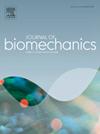髋关节外旋峰值扭矩和单人评分可靠性受 ISOMED2000 测量位置的影响。
IF 2.4
3区 医学
Q3 BIOPHYSICS
引用次数: 0
摘要
髋关节外旋力量(ERS)的测量对于预防和康复非常重要。髋关节外旋力量可在 ISOMED2000 等动测力计的 3 个不同位置进行测量。然而,目前尚不清楚这些测量位置是否会影响 ERS,也不清楚这些位置在 ISOMED2000 中是否可靠。因此,本研究的目的是比较这些位置的 ERS、可靠性和一致性。研究采用横断面设计来比较测量位置,并采用重复测试设计来评估评分者内部的可靠性和一致性。24 名身体健康、运动量大的运动员参加了研究。研究人员在 ISOMED 中测量了运动员在俯卧位、仰卧位和侧卧位时的峰值等长扭矩。不同体位之间的差异采用 Wilcoxon-signed-rank 检验和峭度三角法进行评估。可靠性通过类内相关性进行评估。使用测量标准误差(SEM)、最小可检测变化(MDC)和布兰-阿尔特曼分析(BAA)确定一致性。结果表明,测量位置对 ERS 有明显影响(p 0.74)。所有体位的可靠性和一致性都很高,但侧卧位的可靠性和一致性最高(ICC = 0.90 [0.78, 0.96]; SEM = 0.08; MDC = 0.23; BAA_bias = 3.4 %, BAA_loA = 37 %)。测量位置之间的相关性仅为中差。这些发现表明,测量位置对 ERS 有很大影响。此外,这种影响因人而异,表明标准值不能互换使用,也不能在不同体位之间进行调整。在诊断测试中,应在相同体位下测量 ERS,但最好是侧卧位。本文章由计算机程序翻译,如有差异,请以英文原文为准。
Peak hip external rotation torque and single-rater reliability is influenced by measurement position in the ISOMED2000
Measurement of hip external rotation strength (ERS) is important for preventive and rehabilitative purposes. ERS can be measured in 3 different positions in the isokinetic dynamometer ISOMED2000. However, it is not clear whether these measurement positions effect ERS nor if these positions are reliable in the ISOMED2000. Hence, the purpose of this study was to compare ERS in these positions, the reliability and the agreement. A cross-sectional design was conducted to compare measurement positions and a test–retest design to assess intra-rater reliability and agreement. Twenty-four healthy, physically active athletes participated in the study. Peak isometric torque was measured in the ISOMED in prone, supine, and side-lying position across two sessions on one day. Differences between positions were evaluated with the Wilcoxon-signed-rank test and cliff’s delta. Reliability was assessed via intraclass correlation. Agreement was determined using the standard error of measurement (SEM), minimal detectable change (MDC), and Bland-Altman analysis (BAA). Results indicated a significant influence of measurement position on ERS (p < 0.001) with high effect sizes (>0.74). Reliability and agreement were high in all positions, but highest for the side-lying position (ICC = 0.90 [0.78, 0.96]; SEM = 0.08; MDC = 0.23; BAA_bias = 3.4 %, BAA_loA = 37 %). There were only poor to moderate correlations between measurement positions. These findings suggest that measurement position significantly affects ERS. Furthermore, the effect varies across individuals indicating that normative values cannot be used interchangeably or be adapted across positions. In diagnostic testing ERS should be measured in the same position, but preferably in the side-lying position.
求助全文
通过发布文献求助,成功后即可免费获取论文全文。
去求助
来源期刊

Journal of biomechanics
生物-工程:生物医学
CiteScore
5.10
自引率
4.20%
发文量
345
审稿时长
1 months
期刊介绍:
The Journal of Biomechanics publishes reports of original and substantial findings using the principles of mechanics to explore biological problems. Analytical, as well as experimental papers may be submitted, and the journal accepts original articles, surveys and perspective articles (usually by Editorial invitation only), book reviews and letters to the Editor. The criteria for acceptance of manuscripts include excellence, novelty, significance, clarity, conciseness and interest to the readership.
Papers published in the journal may cover a wide range of topics in biomechanics, including, but not limited to:
-Fundamental Topics - Biomechanics of the musculoskeletal, cardiovascular, and respiratory systems, mechanics of hard and soft tissues, biofluid mechanics, mechanics of prostheses and implant-tissue interfaces, mechanics of cells.
-Cardiovascular and Respiratory Biomechanics - Mechanics of blood-flow, air-flow, mechanics of the soft tissues, flow-tissue or flow-prosthesis interactions.
-Cell Biomechanics - Biomechanic analyses of cells, membranes and sub-cellular structures; the relationship of the mechanical environment to cell and tissue response.
-Dental Biomechanics - Design and analysis of dental tissues and prostheses, mechanics of chewing.
-Functional Tissue Engineering - The role of biomechanical factors in engineered tissue replacements and regenerative medicine.
-Injury Biomechanics - Mechanics of impact and trauma, dynamics of man-machine interaction.
-Molecular Biomechanics - Mechanical analyses of biomolecules.
-Orthopedic Biomechanics - Mechanics of fracture and fracture fixation, mechanics of implants and implant fixation, mechanics of bones and joints, wear of natural and artificial joints.
-Rehabilitation Biomechanics - Analyses of gait, mechanics of prosthetics and orthotics.
-Sports Biomechanics - Mechanical analyses of sports performance.
 求助内容:
求助内容: 应助结果提醒方式:
应助结果提醒方式:


